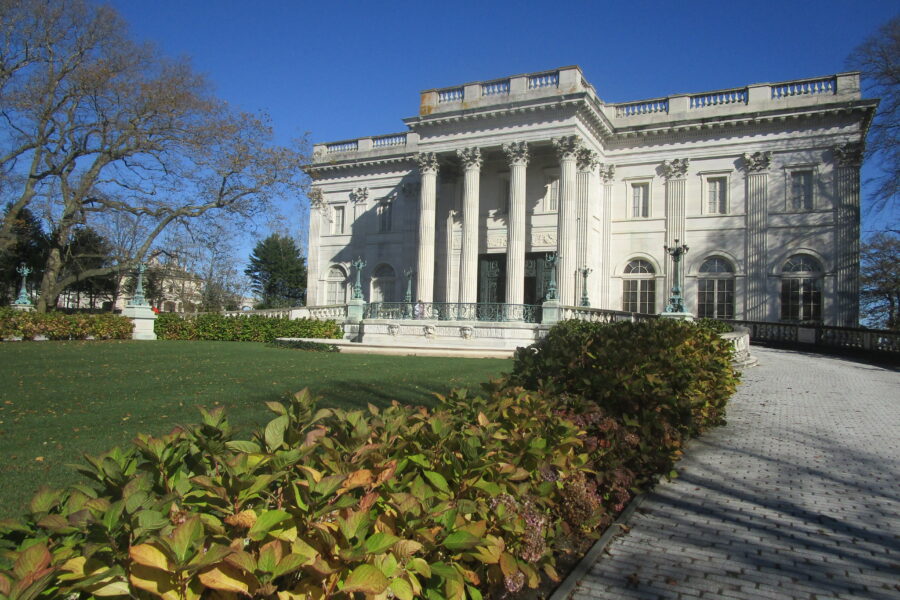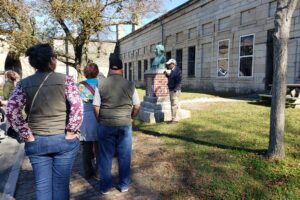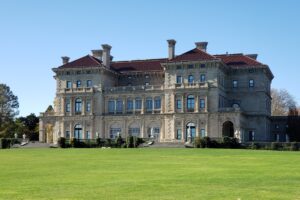As we walk toward the entrance gates, Michael says, “I thought it would be whiter.”
It looks pretty white to me; however, age and black mold have taken their toll in places where the sun cannot reach. After Michael has secured our tickets, we continue our trek toward one more Vanderbilt Summer Cottage — The Marble House — second on the list of must-see mansions in Newport. It seems the Vanderbilt’s have the corner on the market.



The Marble House
Stepping foot into the grand hall, I murmur to Michael, “It is much smaller than the Breakers.”
Built by the brother of Cornelius Vanderbilt, who built the Breakers, the Marble House that William Kissam Vanderbilt commissioned in 1892 for a cost of $11,000, 000 is not only smaller than the Breakers it is more expensive. $4,000,000 more expensive, and William wasn’t trying to outdo his brother. He built his cottage first. Alva Vanderbilt, his wife, apparently had expensive taste, allocating almost 64% of the price to be used for 500,000 cubic feet of marble. The house is a culmination of her dreams, aspirations, wishes, and choices.

If I didn’t walk into another room, I would understand why this is called The Marble House. Italian marble surrounds and envelopes anyone who walks through the massive entrance doors. It is an impressive way to illustrate restrained wealth and elegance.
I turn my attention to the information being fed to me via the audio tour. The narration surprises me as I listen to the story of Alva Vanderbilt telling her husband that if he couldn’t give her the house outright for her 39th birthday, she didn’t want it at all. She sang the tune of — if I don’t totally own it, it isn’t mine.
I don’t think I like her. She sounds spoiled, willful, self-indulgent and self-centered. A definite stereotypical rich bitch.
The Dining Room
Restraint and understatement fall by the wayside as soon as we walk through the doors to the dining room. It is also a sea of marble. And if it isn’t marble that surrounds us, it is gold. Everything that is not marble, not upholstered, or not a painting, is gold encrusted. This is a case of ostentatious opulence. Herein lived a woman who wished to be a queen—Marie Antoinette possibly. The lady of the manor had a definite penchant for the French. I’m not sure this is just a room to impress. It seems more along the lines of something meant to intimidate; thumbing your nose at everyone else.
And, they only lived here six weeks a year.




Alva and William Vanderbilt
Leaving the lavish luxury behind us we enter a marble hallway where there is a painting of Alva Vanderbilt and a bronze sculpture of her husband’s prize-winning racehorse. The audio tour continues to educate us. Alva Vanderbilt was a poor little rich girl from Alabama, whose family lost everything after the Civil War. But she did have one thing going for her — a family name respected by society.

Both Alva’s parents’ families had been in the South a century before the Revolutionary War, and she could trace her lineage to French and Scottish royalty. (Based on all I’ve discovered in my travels about European royalty, I’m not impressed. But perhaps all this explains Alva.)
Alva married for money.
William Kissam Vanderbilt, the grandson of Cornelius “Commodore” Vanderbilt, was considered nouveau riche and shunned by New York’s old money.
William married a name.

If you believe that opposites attract, they were a match made in heaven. Alva was reported to be strong-willed, arrogant, ill-tempered, opinionated, liberated, and tyrannical, traits that purportedly intensified in later life. William was friendly, cultured, even-tempered, gentle, a loving father, and non-combative. Alva considered him to be a “weak nonentity” and marriage to be legalized prostitution. As the years progressed, William allowed Alva to have her way rather than be subjected to her tirades.
I really don’t think I like her. I’m not even sure I want to continue looking at her house. But we are here, and I follow Michael through the maze of marble.
Morning Room/Library
Wandering down a long marble hallway we are led to the Morning Room/Library. I love this room, it is warm and elegant. The beautiful wood-paneled walls, wooden floors, and sumptuous oriental rug are what my material dreams are made of. And, all anyone has to do is load their room with books, and I am hooked. The furniture doesn’t look like anything you could happily curl-up in on a cold rainy Newport morning, but I’m sure I could figure something out.

Gothic Room
Continuing our tour, we come upon the newly restored Gothic Room. I am transported back to England — one of my favorite places. This room is stunning; chairs upholstered in tapestry, stained glass, old wood, candelabras, books, sculptures. I would love to be able to walk into the middle of this space and just sit and stare. The audio guide tells me that is exactly what students of Gothic history used to do. I can’t help but wonder if the students had to have a pedigree to gain admittance.
Alva Vanderbilt’s extravagant collection of more than 300 Medieval and Renaissance art objects purchased as a whole from a collector in Paris, was sold off in 1925 when she decided to close Marble House and move to her chateau in France. The overwhelming bulk of the collection was purchased in 1927 by circus entrepreneur John Ringling for his Sarasota, Florida house and museum.









The Grand Salon
This room is conspicuous consumption on steroids. We are in the middle of a sea of gold. I could say it was stunning, but it appears that it was meant to STUN — any guest that walked through their doors. It is palatial and belongs in Versailles, which is exactly what I think the mistress/owner of the house and her decorator, William Morris Hunt, were aiming for. It is a room that will leave you speechless, gasping for air.






We leave the overstated opulence of the first floor and climb the grand staircase where reception rooms await; one for ladies, one for gentlemen.
William Kissam Vanderbilt
Then we wander into the bedroom of William Kissam Vanderbilt. It is understated compared to the rest of the house. It is also a room he was able to call his own for only eighteen weeks of his life. Alva Vanderbilt divorced him three years after he gave her the Marble House on her 39th birthday. Her grounds for divorce were adultery.
I tell Michael, “If I were her husband, I’d have an affair too.”
To say Michael is shocked is a bit of an understatement, but my gosh the woman married for money and then spent it with a capital “S.” Rumors are that her husband William hired an actress to play the part of his mistress so that Alva would divorce him. I can understand his desperation.
The audio tour quotes William’s feeling of inherited wealth, “Inherited wealth is a real handicap to happiness… It has left me with nothing to hope for, with nothing definite to seek or strive for.”
A statement I have a hard time relating to, it is a stereotypical case of too much, too soon. Perhaps a lesson for us all.

Alva’s Bedroom
Standing here, I can’t help but think once again of a woman that wishes to be a queen. Her bedroom is an expanse of silk and satin and gold. There are swags and swirls and walls upholstered with lavender silk lampas, a richer more elegant sister to damask. Alva’s bed sits on a dais in the center of the back wall. As soft as the colors and the fabrics are the room still looks imperious, like the woman who slept here.

Other Bedrooms
The bedrooms that surprise me most are those belonging to the children. The rather masculine, royal looking bedroom belongs to their delicately beautiful daughter, Consuela. The smaller, simpler pastel-colored bedrooms belonged to the sons. There is only one guest bedroom — which is very grand and very pink.
The Basement
I like the basement. Of course, I like the basement. It is where I feel most comfortable, amid pots and pans and pottery and chopping blocks.








The Grounds
Exiting the marble manse, we make our way across the grounds to the Chinese Teahouse that faces an expanse of blue. Sky and water. Michael and I sit inside munching on cakes and muffins and drinking hot coffee. Enjoying the warmth, I take my time, apparently too much time in consuming the sweet blueberry confection. Michael pushes his chair away from the table and tells me he is going outside to look around. When I follow a few minutes later, he has disappeared. He should be nicknamed Houdini. I find him at the edge of the cliff, gazing out to sea.






The Rest of the Story
I still don’t like Alva Vanderbilt, although Michael thinks—or at least pretends to think—that I am judging too harshly. She was a fortune hunter, fortune spender, married twice to millionaires of her time (billionaires today). But, I do have to give her some credit, she was also a pioneer in many areas, and relentless when it came to championing causes that she believed in. One of which was the Woman’s Suffrage Movement.
A Party to End All Parties
She appears to be a major trend-setter of her era being the first society woman to demand and receive a divorce and still retain her social position. She single-handedly propelled the Vanderbilt’s into high society by giving a costume ball for 1,000 people at a cost of $3,000,000, then conveniently forgot to invite the Astor’s. Lady Astor’s daughter was devastated since it was to be the party of the century. In a nutshell, Lady Astor was forced to make a personal plea to Alva for the Astor’s inclusion.

Consuelo Vanderbilt
Alva decided that her daughter, Consuelo, would marry into English nobility by wedding Charles Richard John Spencer-Churchill, the Ninth Duke of Marlborough. Because he was land poor, an infusion of the Vanderbilt cash would be a boon to him and his family estate. Consuelo wanted to marry someone else. However, Alva was so determined that she marry the Duke, she placed a guard at her daughter’s bedroom door on the eve of the wedding to prevent her from running away to her true love. This little bit of manipulation cost William Kissam $10,000,000 in the form of a dowry. The marriage didn’t last.

Alva Remarries
Nine months after her divorce from Vanderbilt Alva married Oliver Hazard Perry Belmont. A man who had deserted his first wife on their honeymoon to travel in Spain with a French dancer. Belmont was five years younger than Alva and was apparently more interested in having a good time than attending to the family business. He also had an inordinate love for his horses, bordering on the bizarre. Barely 12 years after their marriage he died, leaving Alva Smith Vanderbilt Belmont his entire fortune, which consisted of several mansions and $10,000,000.
Redemption
Among other worthy pursuits, Alva became a major organizer and participant in the movement for woman’s suffrage. To raise money for the cause of woman’s suffrage, she endorsed Ponds Cold Cream, Simmon’s mattresses, and silverware in advertisements.
However, her positions appear to be extreme. She advocated a national hunger strike and the boycott of all jobs by women. When women were finally given the vote, Alva urged them not to vote until men relinquished their monopolistic control of political parties. She once said of herself, “I blaze the trail for the rest to walk in.”
She was a woman to be reckoned with. I’m still not sure I like her.













Leave a Reply
Your email is safe with us.